Easy Clotted Cream Recipe (What Works…and What Doesn’t!)
This article may contain affiliate links. See our disclosure link for more information.
If you want to make homemade Clotted Cream, this is for you!
I’ve made it many, many times now, and I’m about share all the details about what works…and what doesn’t, so you can make perfect clotted cream on your first try.
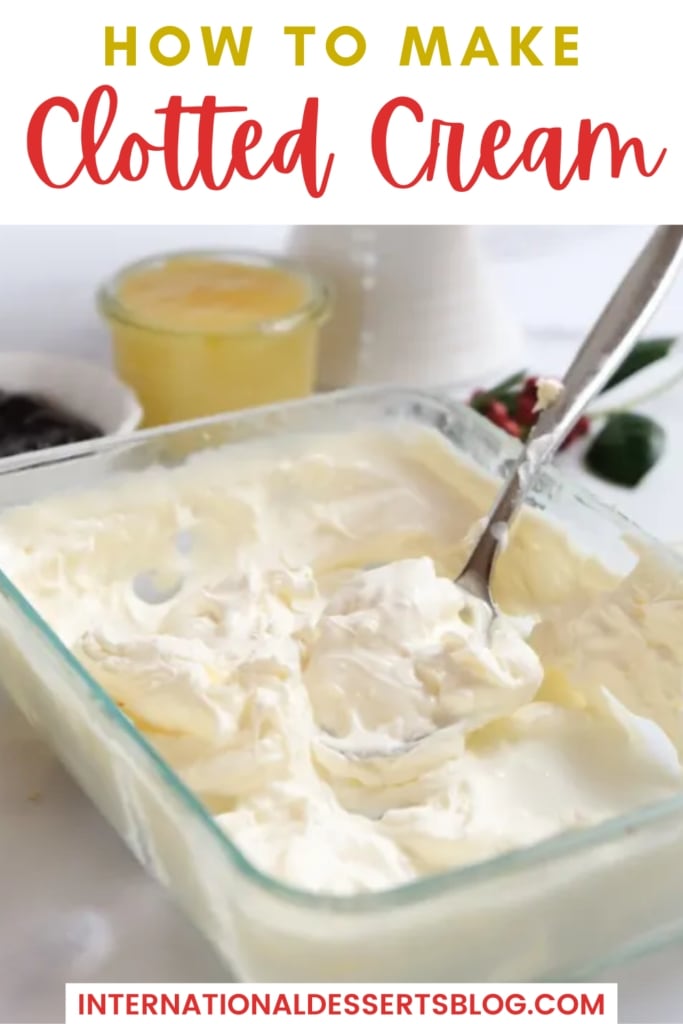
If you want to get right to the recipe, click “jump to recipe” or scroll aaaaaall the way down.
If you want to read answers to some frequently asked clotted cream questions and about the clotted cream experiments that led to my now perfected recipe, keep reading. Don’t forget to download your Clotted Cream Cheatsheet below.
I was so excited to realize that I can make British-style clotted cream at home to eat on my favorite fresh-from-the-oven currant scones.
You won’t believe how easy it is!
If you can pour cream into a dish, you can make homemade clotted cream.
The hardest part of the recipe? Waiting the 24 hours you need to bake, and then chill, the delicious cream before devouring it.
Some of you are probably salivating at the thought of slathering fresh clotted cream on a scone and then topping it with jam (or the other way around), while others are probably wondering, what in the world is clotted cream? What is clotted cream used for?!
Read on, my friend, and I’ll tell you all about it. 🙂 If you’d rather skip reading about my clotted cream experiments and get right to the recipe, just scroll all the way down.
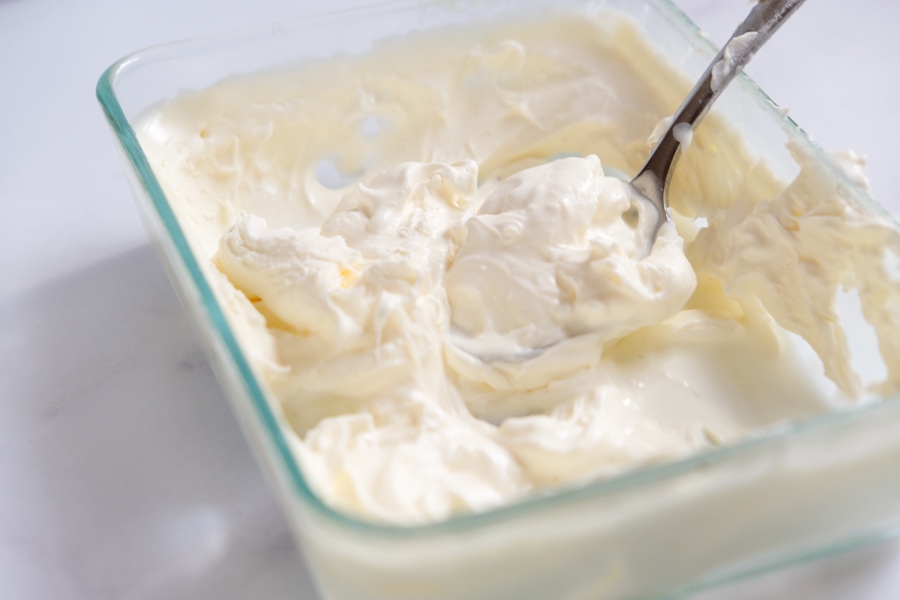
Contents
- 1 What is Clotted Cream?
- 2 What Does Clotted Cream Taste Like?
- 3 What to Do with Clotted Cream?
- 4 Clotted Cream FAQ
- 5 How to Make Homemade Clotted Cream
- 6 Round #1: Getting Started
- 7 Round #2: Maybe Foil Would Help?
- 8 Round #3: Starting to Get It Right
- 9 Round #4: Trying a New Method
- 10 Round #5: Let’s Try the Slow Cooker
- 11 Round #6: I Found THE ONE – The Best Clotted Cream Method!
- 12 Clotted Cream Troubleshooting & Tips
- 13 Looking for More British & Irish Recipes?
- 14 How to Make Homemade Clotted Cream
- 15 Easy Clotted Cream Recipe
- 16 Rather Buy Clotted Cream?
- 17 And then add a jar of lemon curd….
- 18 …and strawberry jam!
- 19 Easy Homemade Clotted Cream Ice Cream
- 20 Clotted Cream Ice Cream
What is Clotted Cream?
Don’t be put off by the name!
Clotted cream, sometimes also called Devonshire or Cornish cream, is a thick cream that often accompanies scones in the UK.
The slow heating and cooling process allows the cream to separate and for the “clots” to rise to the surface.
Made from cow’s milk (well, cream) this is not a low fat food. The fat is what makes it so creamy and to-die-for delicious!
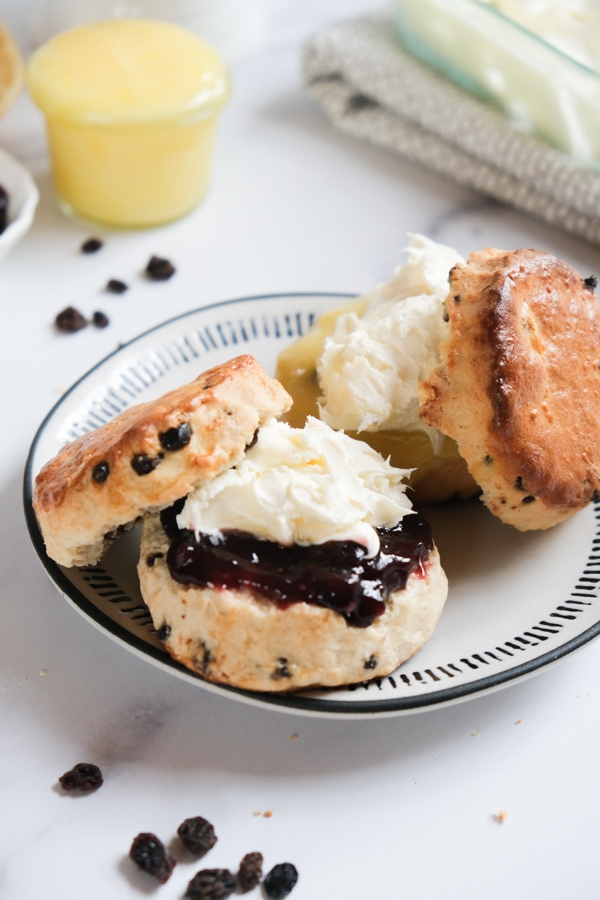
What Does Clotted Cream Taste Like?
The texture and taste of clotted cream can vary, depending on the cream you use and how you cook/bake it, as you’ll see via my experiments below.
The taste is unique and not like anything we typically eat in the US. It’s like a cross between butter and unsweetened whipped cream.
You can easily make a batch using my easy clotted cream recipe below. Another option is order a small 1 oz jar of clotted cream to try before making it at home.
Clotted cream is absolutely delicious slathered on my fluffy currant scones and topped with my homemade lemon curd, jam, even my German Plum Butter.
Clotted cream and scones are perfect for hosting an afternoon tea, birthday party, office party, shower, holiday party…or as a delightful afternoon treat with a steaming hot London Fog, Fresh Mint Tea or Earl Grey.
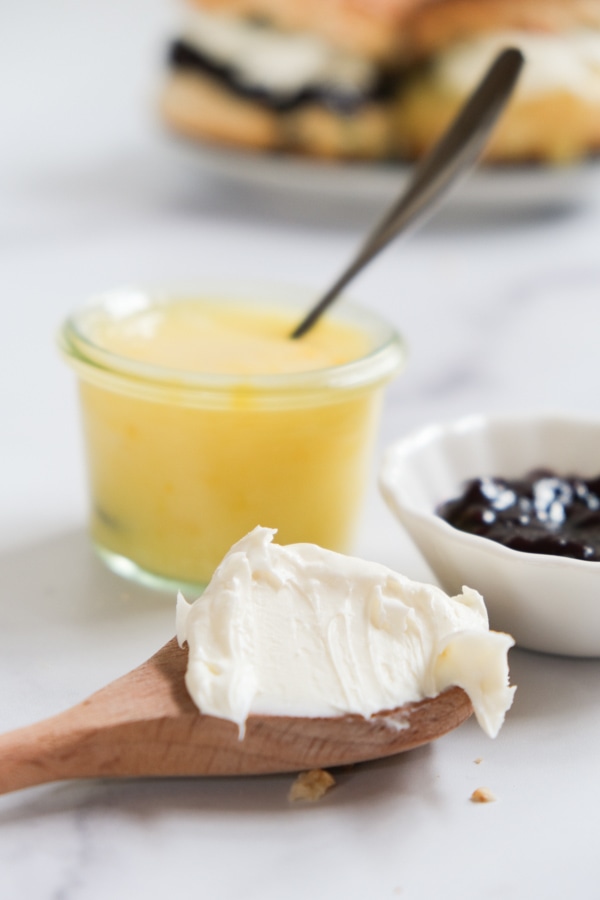
What to Do with Clotted Cream?
Here are some other uses for clotted cream. Besides the typical scones and clotted cream pairing, it’s amazing slathered on…
- muffins
- crumpets
- quick breads
- cornbread
- Irish soda bread
- rolls
- pancakes
- waffles
- french toast
- treacle tart
- German Stollen bread
You can also use clotted cream in…
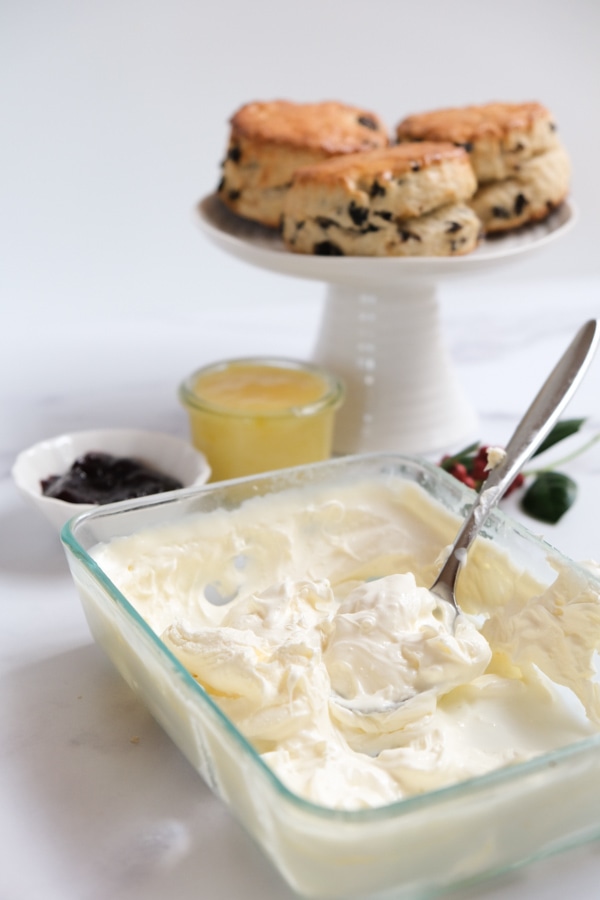
Clotted Cream FAQ
Can I freeze clotted cream?
Yes! Freezing clotted cream is easy, just put it in a freezer safe container. But I seriously doubt you have any left over to freeze.
How many calories are in clotted cream?
Do you really want to know that? It’s made from heavy cream so looking at the calorie count on the heavy cream you choose to use will give an idea.
Can you make slow cooker clotted cream?
Yes! I always make it in the oven but from what I’ve been told, you can use a slow cooker instead.
Where can I buy clotted cream in the USA?
If you’d rather buy clotted cream than make it, try Trader Joe’s, Whole Food or Wegmanns. Or grab a jar of clotted cream here on Amazon.
Where can I buy individual portions of clotted cream?
You can get little 1 oz jars of clotted cream right here. How cute would individual jars be for brunch, tea or a shower?
What kind of cream should I use?
First, use the highest quality cream you can (organic, grass-fed, local, etc) with a high fat content.
Second, only use pasteurized cream, NOT ultra-pasteurized cream.
The ultra-pasteurized stuff just doesn’t work as well (if at all).
I’ve tried it (see “Round 1” below) several times, and I can say from experience, you’ll get the very best results with non-ultra pasteurized cream and will be disappointed if you use ultra-pasteurized.
Where to find NON-ultra-pasteurized cream? I get it from my local co-op or Whole Foods.
That said, readers have said that they’ve gotten good results with ultra pasteurized heavy cream! So give it a try if you’d like. If it doesn’t work try it again with non-ultra pasteurized cream.
Update: a reader suggested Organic Valley ultra pasteurized cream, so I picked up a pint at Whole Foods. The clotted cream it made wasn’t as thick, creamy or smooth as when I use non-ultra pasteurized cream but it was MUCH better than any other ultra pasteurized cream I’ve tried.
I’m going to stick with using non-ultra pasteurize cream from our local dairy (it works better and it’s cheaper) but I’m so glad to have another option!
One more thing – from what I’ve been told, unpasturized cream is what works THE BEST.
I haven’t been able to find it where I live so I haven’t tried it yet. If you have access to unpasturized cream, you might want to give it a try.
Créme frâiche vs clotted cream…what’s the difference?
While both are made with heavy cream, they are quite different.
Créme frâiche is made by adding buttermilk, whereas clotted cream has nothing added to it. Créme frâiche develops by sitting at room temperature, while clotted cream needs to be baked.
Créme frâiche is a “soured cream” that has a tang. Clotted cream is more like a cross between butter and whipped cream. Click here to try my easy Créme frâiche recipe!
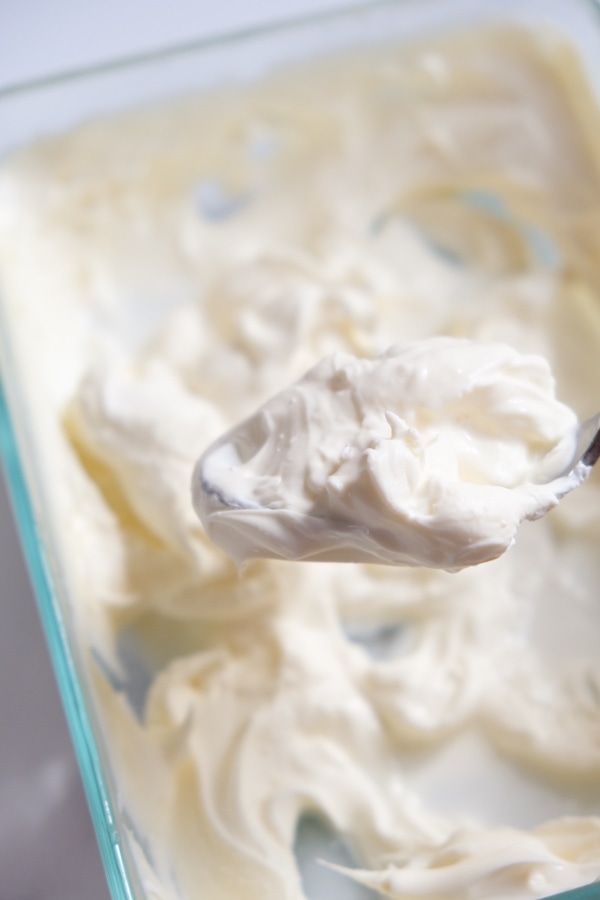
How to Make Homemade Clotted Cream
I’ve made many batches of clotted cream in a variety of ways in order to see what works the best.
What follows are my various experiments so you can see what worked and what didn’t.
The “official” recipe at the end of this article is the method I found worked the best. I’ve included some tips below, as well as troubleshooting tips just before the recipe.
A few notes before we get started:
Cream. I’ve had much better luck with non ultra pasteurized heavy cream (so just organic, pasteurized cream, from our local dairy, purchased at my local grocery coop).
Readers have told me that they’ve used ultra pasteurized cream — the kind you typically find at the grocery store — but, unfortunately, that’s never worked well for me, and I’ve tried several different kinds of cream.
— Update: see my note above about Organic Valley ultra-pasteurized cream! — Other readers have said that using un-pasteurized cream works the best – but I haven’t tried that yet.
Oven. I have a double oven and had much better luck using the large oven. I tried making clotted cream in the smaller top oven and it just didn’t turn out right.
Baking dish. I used to use a Pyrex 8×8 glass baking dish (like this one) for 1 pint (2 cups / 450ml) of cream but have found much better results using a 3-cup Pyrex glass baking dish (like this one).
Try, try again! One of the reasons I’ve done so many clotted cream experiments is because sometimes my clotted cream would turn out and sometimes it didn’t.
Fortunately, I get pretty consistent results now. So, if your clotted cream doesn’t turn out the way you want the first or even second time, make some notes and try again!
Timing. If you’re making clotted cream for a special occasion, make it a few days in advance. That way, if your first batch doesn’t turn out the way you want, you have time to remake it.
Ok, let’s get to my clotted cream experiments!
If you want to go right to the method I now use to get perfect clotted cream every time, scroll down to Round 6. I hope sharing all of this will help you get better clotted cream more quickly!
Round #1: Getting Started
I poured one pint (2 cups / 450ml) of regular grocery store heavy cream into an 8×8 glass baking dish and let it sit uncovered in a 180F/82C oven for 12 hours. This is what it looked like at the end of those 12 hours:
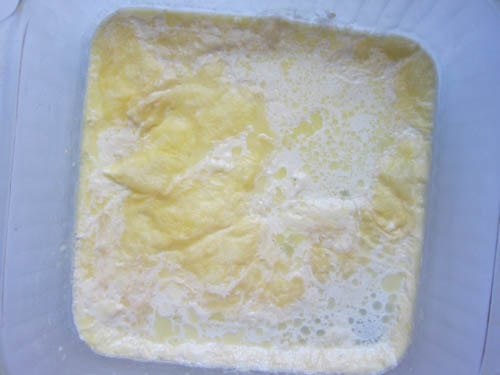
The yellow stuff on top is the clotted cream.
I spooned it into a jar and used the milky leftovers in a batch of scones.
It’s always a good idea to make clotted cream the day before you want to make scones so you don’t waste any of the leftover cream/whey.
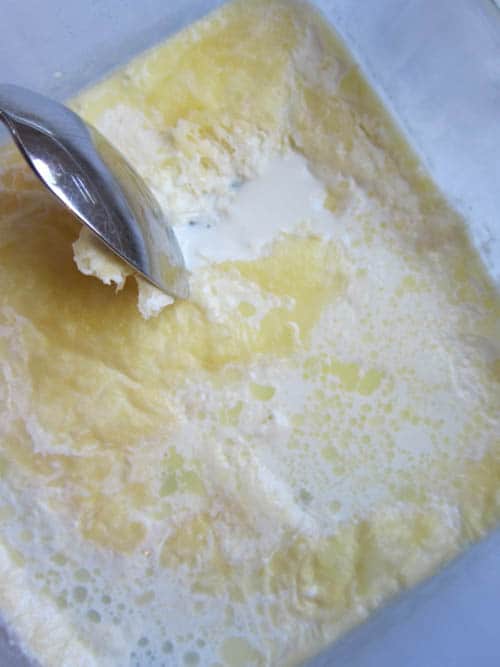
For this first round, I used a pint of heavy cream from Trader Joe’s – just regular old heavy cream.
Later I realized that it was ultra-pasteurized, which clotted cream experts advise against using. I found that it worked ok but not great.
I much preferred the cream that was made with local organic pasteurized cream (see Round #3).
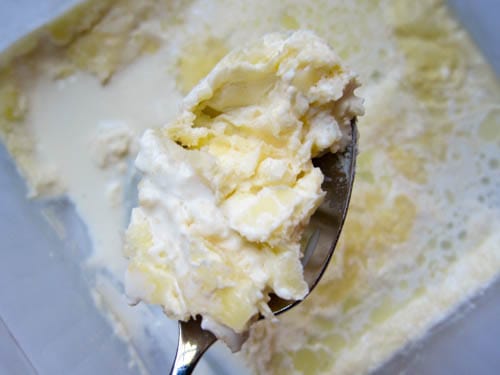
This batch of clotted cream tasted good but was a bit gritty and had the worst texture of all my clotted cream experiments.
Round #2: Maybe Foil Would Help?
The second time around, I did everything the same as the first time, except that I covered the dish with foil.
I thought that might create a smoother texture.
Here’s what the cream looked like after 12 hours in the oven:
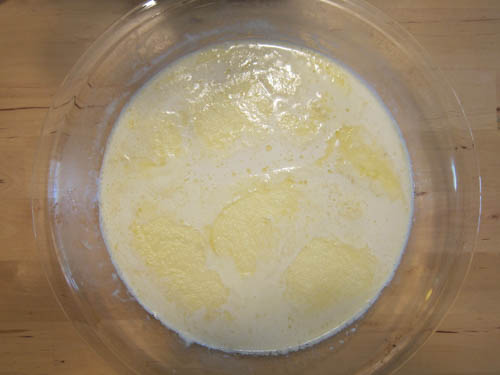
This batch wasn’t gritty…but it was soupy.
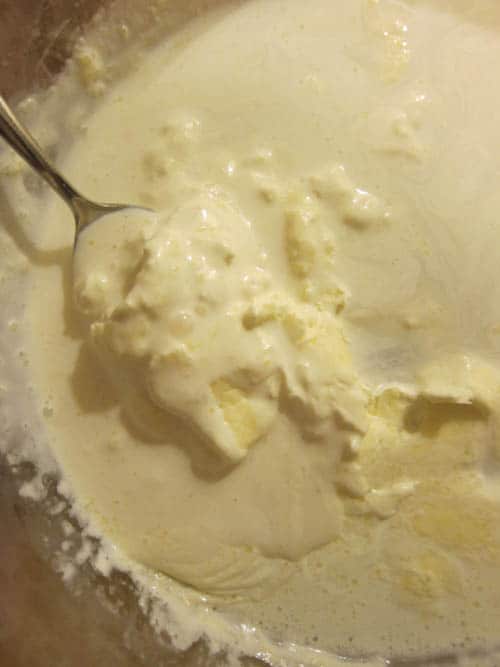
You can see in the photo above that the texture was quite different from the first round.
And the only difference was that this batch was covered in foil!
I liked the taste of this batch, and it was smoother than the first, but it was a little too runny for scones.
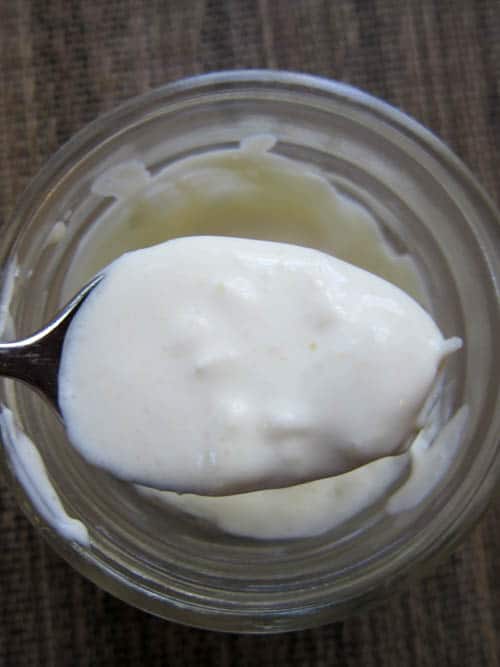
Round #3: Starting to Get It Right
The first batch was too gritty, and the second too runny, but the third batch was perfect!
When I realized that I’d been using ultra pasteurized heavy cream I decided to try two pints of local, organic, pasteurized heavy cream.
I used a larger baking dish and left it uncovered, but the cream was in the oven at the same temperature (180F/82C) for the same amount of time. After 12 hours, the clotted cream looked like this:
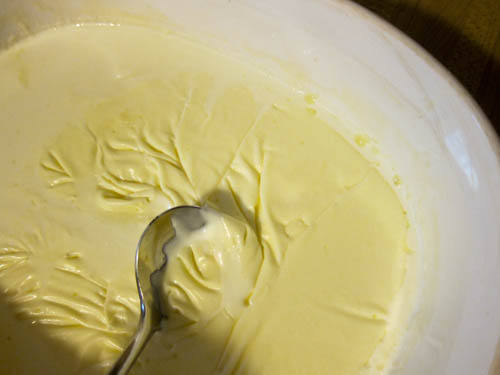
As I mentioned, this was my favorite batch by far! The clotted cream was smooth, thick, and rich. The perfect texture for scones. After separating the clotted cream from the liquid cream and then chilling the clotted cream overnight, this is what it looked like:
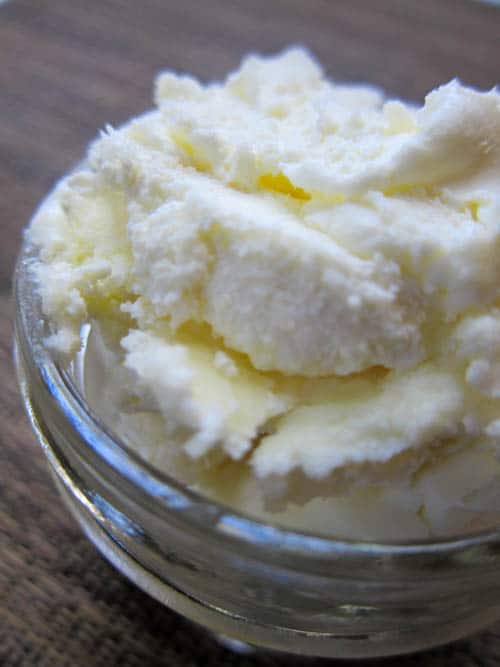
The texture was buttery smooth, easy to spread on a scone, and delicious with jam. Success!
The only downside to this batch was that only half of the cream clotted.
That part was out of this world, but I was left with a small jar of separated liquid cream.
I used it in other baking recipes, so it didn’t go to waste, but I was disappointed that this round didn’t make very much clotted cream.
So, it worked but not as well as I’d like.
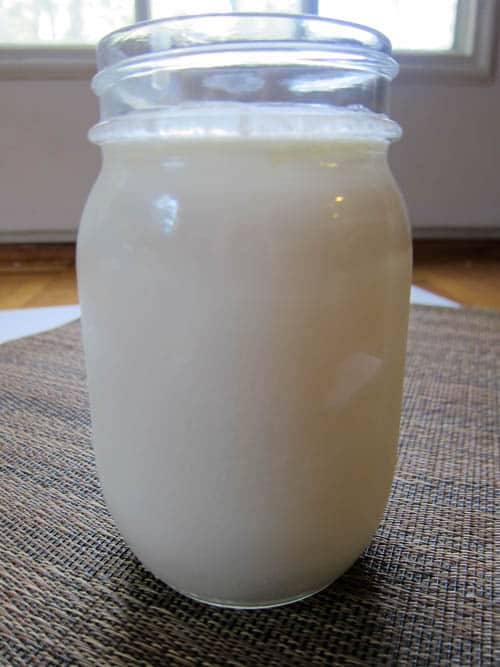
Round #4: Trying a New Method
I recently heard someone swear by this next method because it results in completely smooth and creamy clotted cream with none of those thick butter-like clumpy bits. I gave it a try and wanted to share it with you!
Here’s what you do:
- Heat oven to 360F/182C
- Pour clotted cream into a baking dish and cover with foil – I used 1 pint (2 cups / 450ml) of non-ultra pasteurized heavy cream
- Place cream in oven
- Turn oven off
- Take cream out of oven 12 hours
- Chill in the fridge for 12 hours
- Scoop clotted cream into a dish
Here’s what my clotted cream looked like after following this method (this was after baking and chilling)…
My clotted cream was definitely smoother and creamier!
I loved that there were no chunky bits and it wasn’t gritty or lumpy at all. There was still a fair amount of whey, but that’s to be expected.
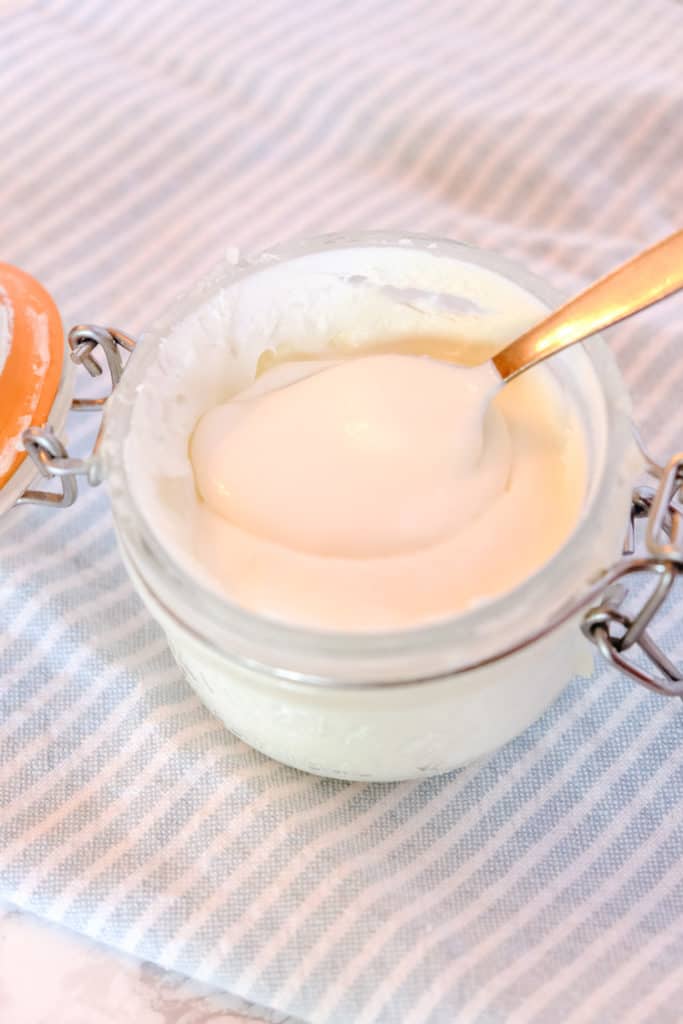
I think I transfered a little too much whey when I scooped the clots of cream into a jar, which made it runnier than normal.
That said, it did thicken up after another 12 hours in the fridge. But it didn’t have the same butter-like consistency that I usually get.
It still tasted amazing, even if it was more pourable than spreadable.
Round #5: Let’s Try the Slow Cooker
I recently tried making clotted cream in a slow cooker. I completely forgot to take photos but I wanted to share the results with you.
While I like that you can let it cook all day or night while you’re not at home (I don’t like to leave my oven on when I’m not in the house) I didn’t love the final product as much.
The first round cooked on the “low” setting on my crock pot. But that was too high a temperature.
The top of clotted cream turned dark and the texture was lumpy yet thin.
So, for the next round, I cooked it on “warm” for about 12 hours.
That turned out better but I ended up with only a small amount of clotted cream.
Some people swear by using a crock pot to make clotted cream. It worked ok for me set to warm but after this I’ll stick to using the oven.
Round #6: I Found THE ONE – The Best Clotted Cream Method!
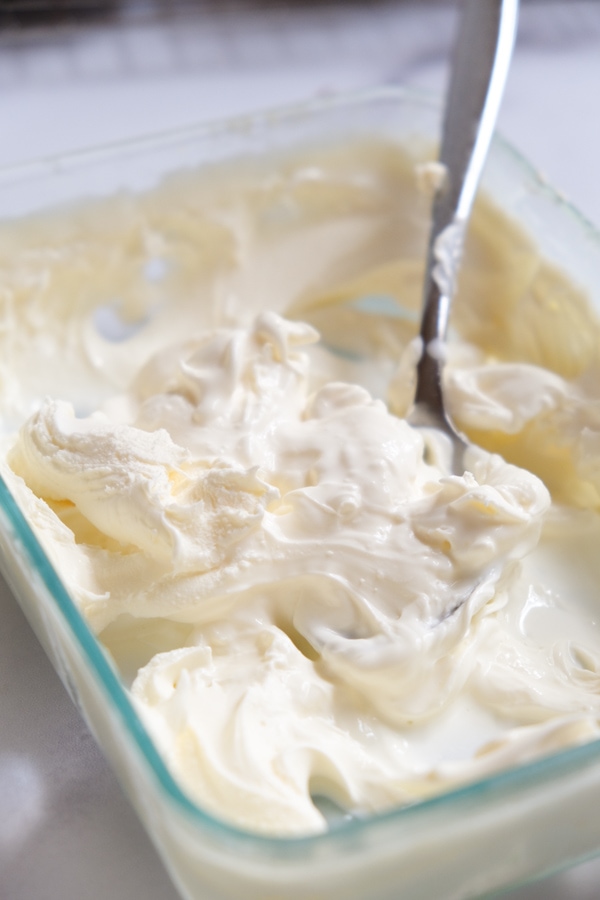
Recently I needed to make a batch of clotted cream but I couldn’t make it the way I usually do – 12 hours in a 180F/82C oven – because I wasn’t home most of the day, and I don’t like to leave the oven on when I’m not in my house.
So I tried a new method, basically by accident.
This batch turned out the best of all of my clotted cream experiments!
I make my clotted cream this way and get excellent results every time.
Here’s what I did:
First, I heated my oven to 360F/182C (if you have a double oven, use the larger one).
Then I poured 1 pint (2 cups / 445 g / 472 ml) of non-ultra pasteurized organic local heavy cream into a 3-cup Pyrex dish (this one) and covered the dish with foil — see photos below.
I put the cream in the oven and turned off the heat.
And then left the house for about 3 hours.
When I got home, I turned the oven back on to 180F/82C and let it bake for about 7 hours.
After taking the cream out of the oven (the cream still looked white and runny at this stage) and letting it cool to room temperature, I let the clotted cream chill in the fridge overnight (about 12 hours).
The next day I carefully poured as much whey as possible into a jar and then scooped the clotted cream into a dish.
This is easy to do if you use a 3-cup Pyrex dish and a spoon to hold back the clotted cream.
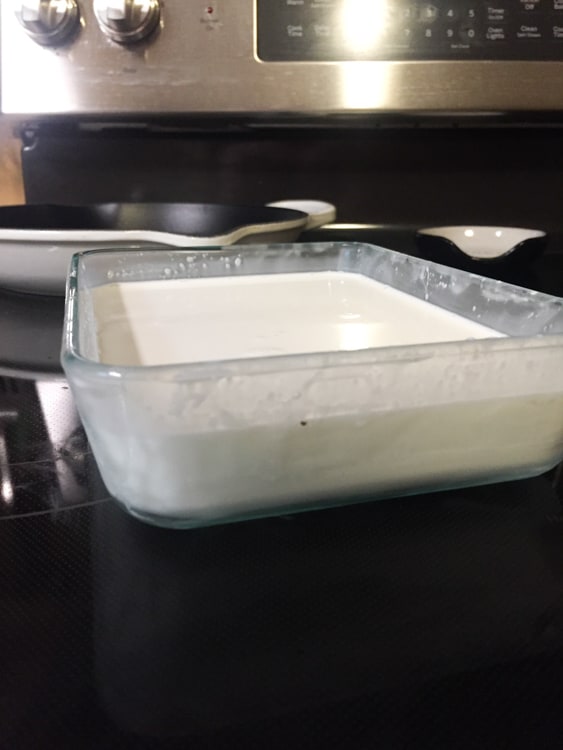
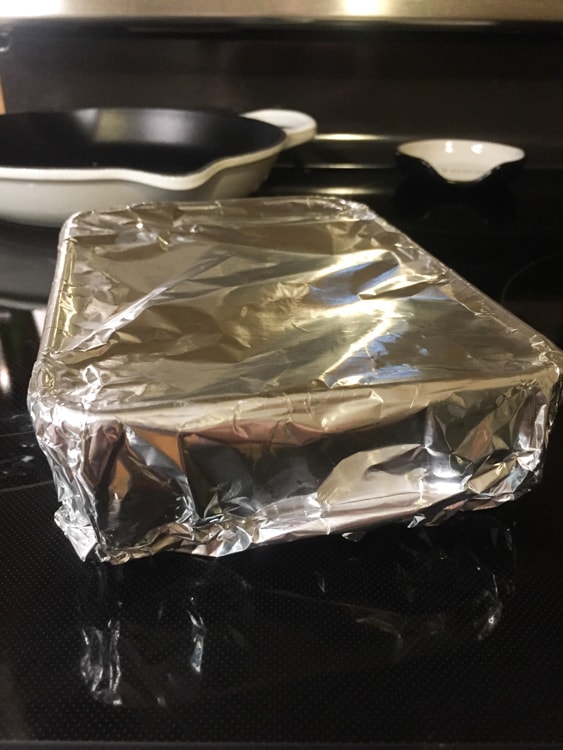
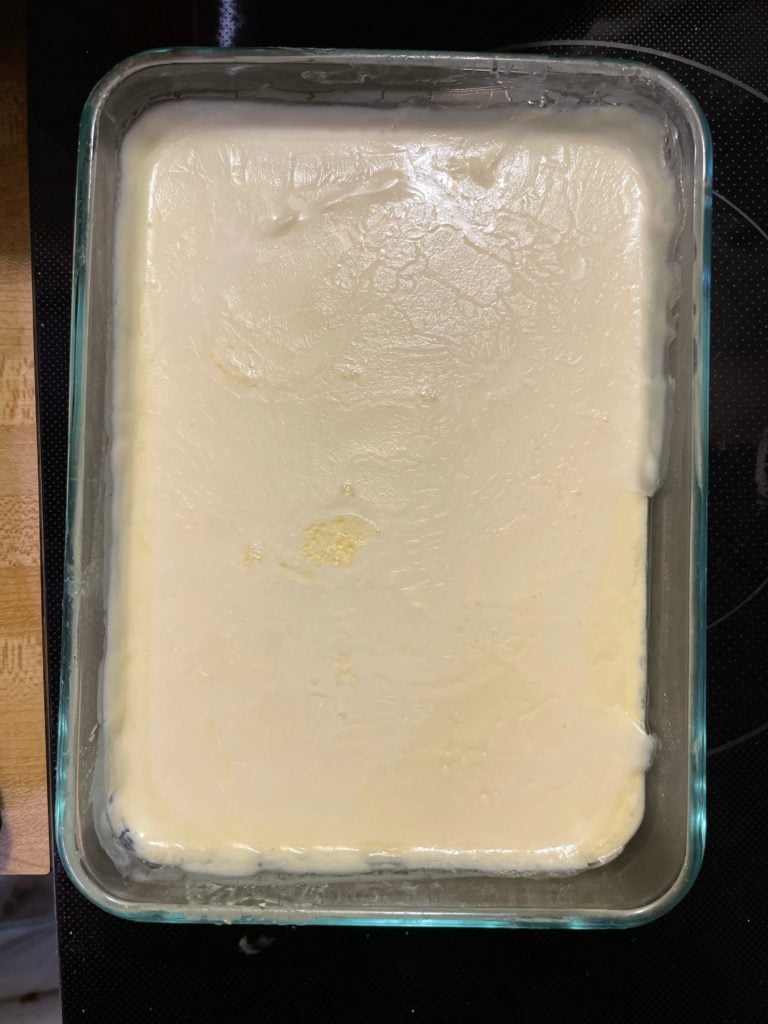
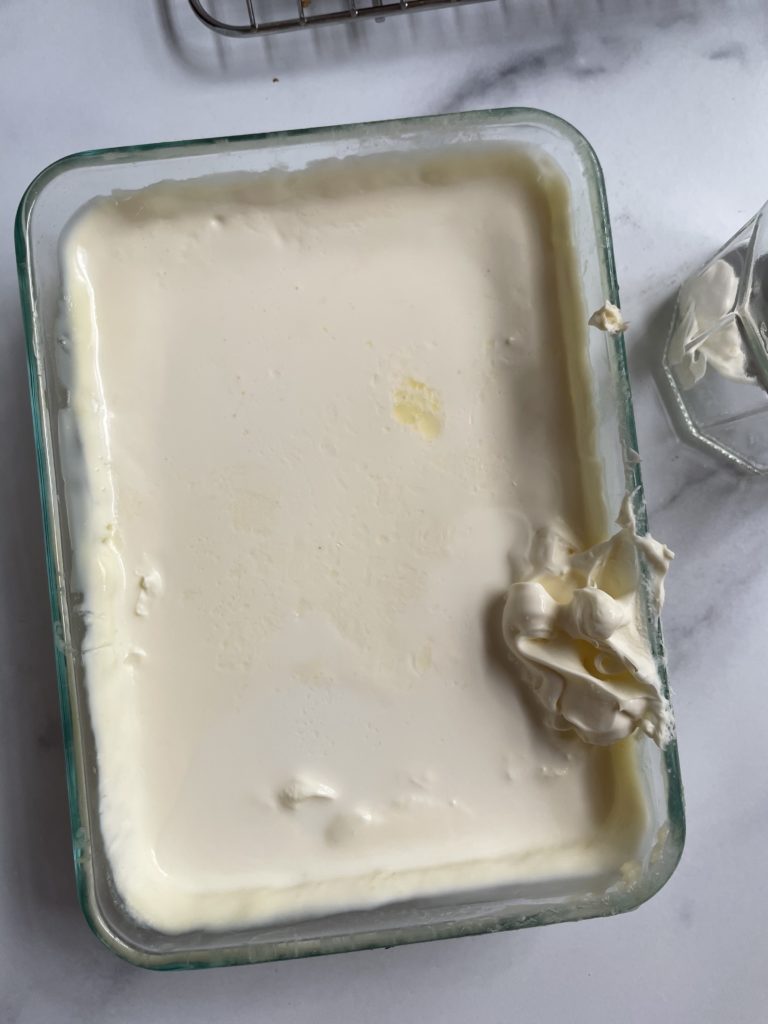
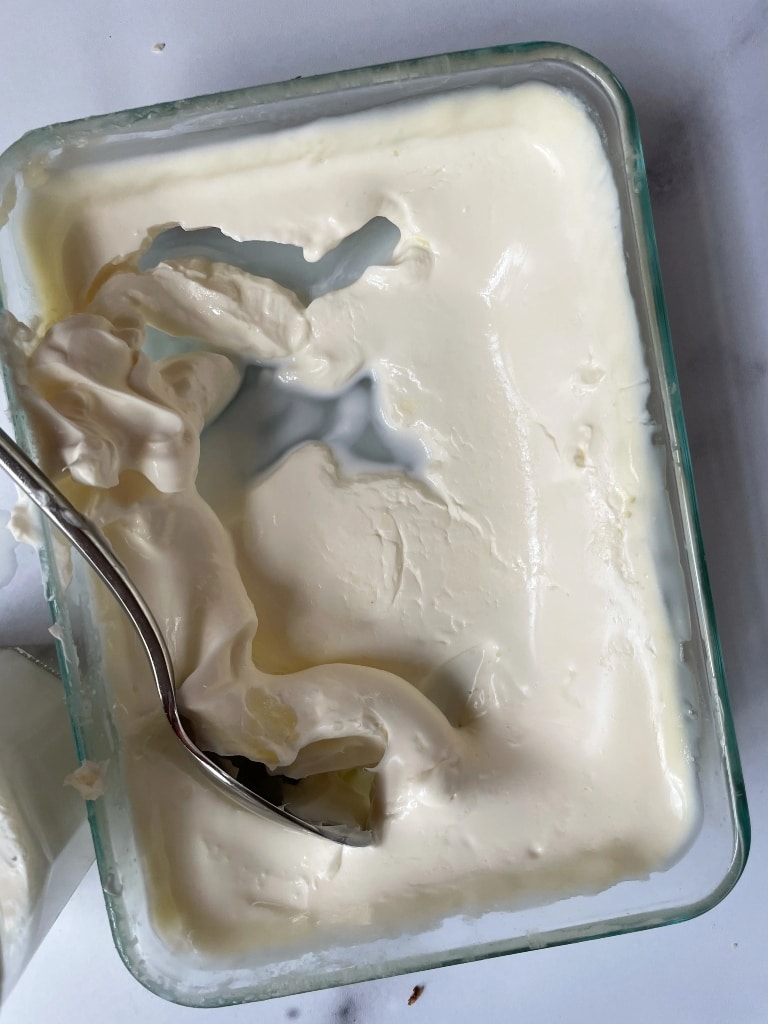
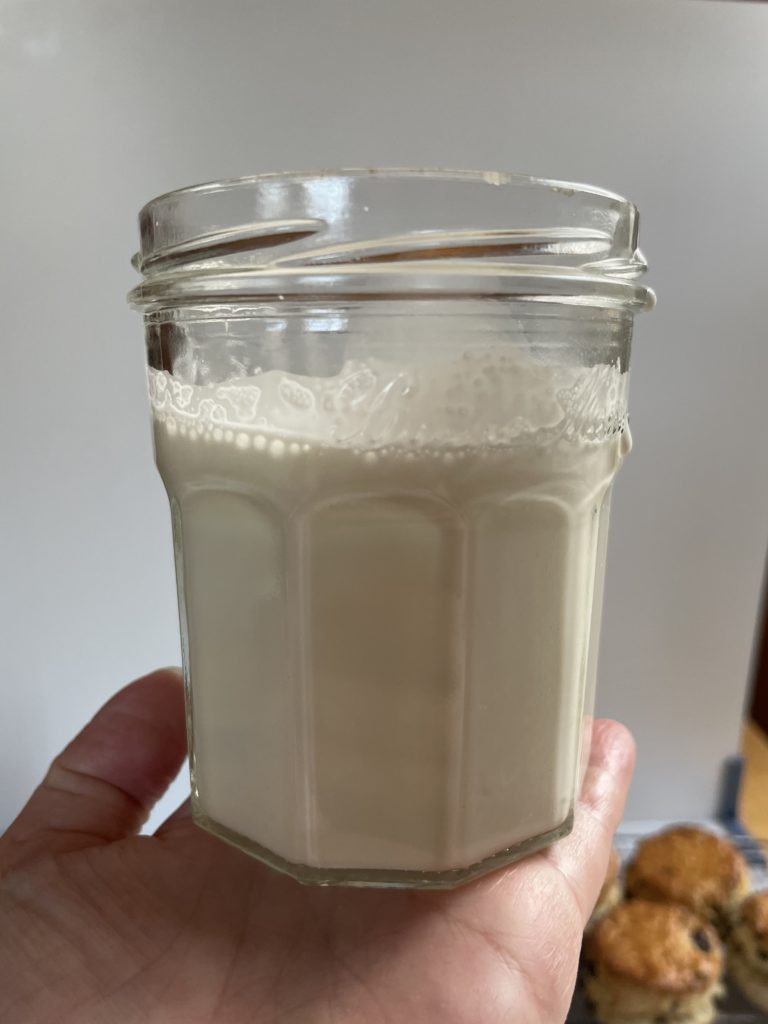
This batch turned out awesome!
It was thick, creamy, white, smooth, and yielded the most clotted cream of any batch I’ve ever made.
I’ve since made clotted cream using this method several times and have found success each time!
I’ve gotten the best results when using a 3-cup Pyrex dish like the one below. It’s perfect for 1 pint (2 cups/454ml) of cream.
The size also makes it super easy to drain off the whey before scooping out the clots of cream, which results in thicker clotted cream.

Clotted Cream Troubleshooting & Tips
If your clotted cream didn’t turn out the way you expected, don’t worry.
There are several factors that affect how your clotted cream turns out, and it might take a few tries to figure out what works for you. Here are a few troubleshooting tips from my experience:
1. My clotted cream is too runny.
- Did you use non-ultra pasteurized heavy cream?
- Did you bake it long enough?
- Have you chilled the clotted cream in the fridge for 12 hours?
- Did you separate the whey from the clots of cream after baking and chilling?
- Did you drain off the whey before scooping out the clots of cream?
- Did you transfer more whey than you realized when scooping the clots of cream into a bowl?
- I find that my clotted cream is too runny when I use ultra pasteurized cream, don’t let it chill long enough or transfer too much whey when scooping out the clots of cream.
2. My clotted cream is gritty or lumpy.
- Did you bake your clotted cream uncovered? If so, try covering the dish with foil.
- You can also try using a different kind of cream.
3. I didn’t end up with very much clotted cream.
- Try using a smaller baking dish.
- Or, if you used ultra pasteurized cream, try using non-ultra pasteurized cream.
- You might also need to chill it longer.
- I highly recommend also making these easy scones and lemon curd to go along with your clotted cream!
Looking for More British & Irish Recipes?
- Easy homemade Golden Syrup
- How to make perfect scones
- Clotted cream the easy way
- Easy Irish Soda Bread
- Best ever Mini Mince Pies
[cboxarea id=”cbox-aiGSulWU62B3RslF”]
How to Make Homemade Clotted Cream
Easy Clotted Cream Recipe

Your life will never the be same after making clotted cream. It's easy to make and delicious on scones!
Ingredients
- 1 pint (2 cups / 450ml) heavy cream (NOT ultra-pasteurized)
Instructions
- Heat oven to 360F/182C.
- Pour heavy cream into a 3-cup Pyrex glass baking dish (or similar) and cover with foil.
- Place in oven.
- Turn oven off.
- Let cream sit in oven for 3 hours.
- Turn oven back on to 180F/82C and let cream sit in oven for 7 hours.
- Take clotted cream out of oven and let cool to room temperature.
- Then chill clotted cream in the fridge for about 12 hours.
- Using a spoon to hold back the clots of cream, drain off as much of the whey as possible into a jar or glass. Then scoop the thick "clotted" clumps of cream into a jar or bowl (or just leave it in the pyrex). If your clotted cream is thicker than you'd like, add a couple spoonfuls of whey back into the cream.
- Spread clotted cream on scones (or waffles, pancakes, etc), top with jam or lemon curd, and enjoy with a cup of tea!
Notes
Rather Buy Clotted Cream?

Click here to get a 6oz jar of English clotted cream.

Click here to get a case of 12 or 24 1 oz individual portions of clotted cream.
And then add a jar of lemon curd….

Click here to add a jar of lemon curd.
…and strawberry jam!
Click here to add a jar of strawberry jam.
Easy Homemade Clotted Cream Ice Cream
Now that you’ve got clotted cream, try making this easy no churn ice cream!
Adding clotted cream gives the ice cream a unique flavor and creamy texture. It’s the perfect base for all of your favorite toppings.
And you don’t even need an ice cream maker if you use this recipe!
Clotted Cream Ice Cream

This easy and deliciously rich and smooth no
churn ice cream is perfect for all kinds of toppings!
Ingredients
- 2 cups [480 g] heavy cream
- 1 cup [300-350 g] sweetened condensed milk (or golden syrup, honey or other sweetener)
- 1 cup [245 g] milk
- ¼ teaspoon salt
- 2 teaspoon vanilla extract
- ½ cup [115 g] clotted cream
Instructions
- Whip heavy cream to stiff peaks.
- Meanwhile, pour milk, sweetened condensed
milk (or other sweetener), salt and vanilla extract into a medium sized mixing bowl. Stir well. - Add clotted cream and stir until well combined.
- Once the heavy cream has reached the stiff peaks stage, carefully fold a scoop of cream into the milk. Then fold the rest of the whipped cream into the milk until combined (but don't totally deflate the whipped cream).
- Pour ice cream into an ice cream container, cover tightly, and add freeze for at least 4 hours.
- When you're ready to serve the ice cream, let it stand for a few minutes before scooping. Caution: once scooped the ice cream
will melt quickly!

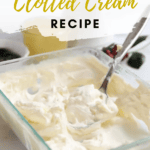
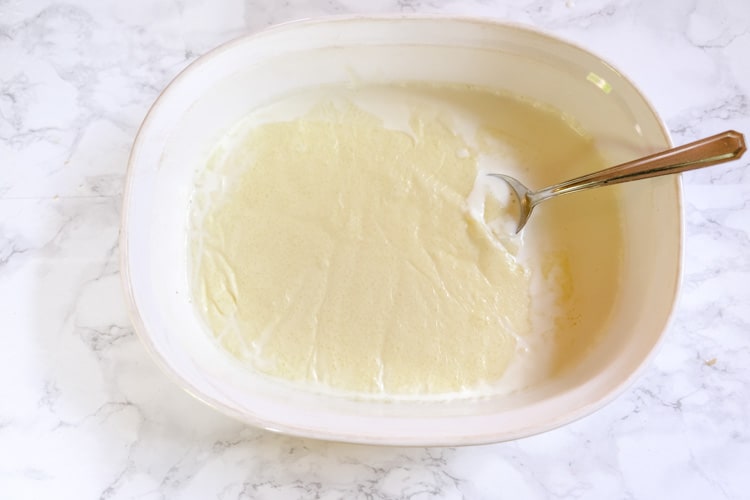
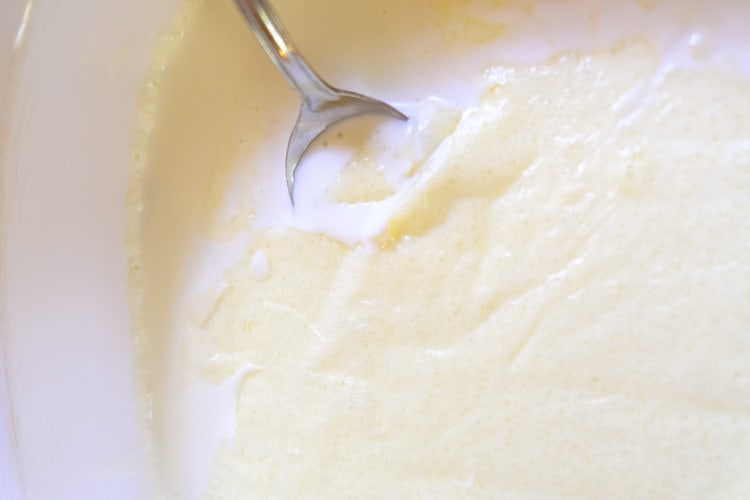


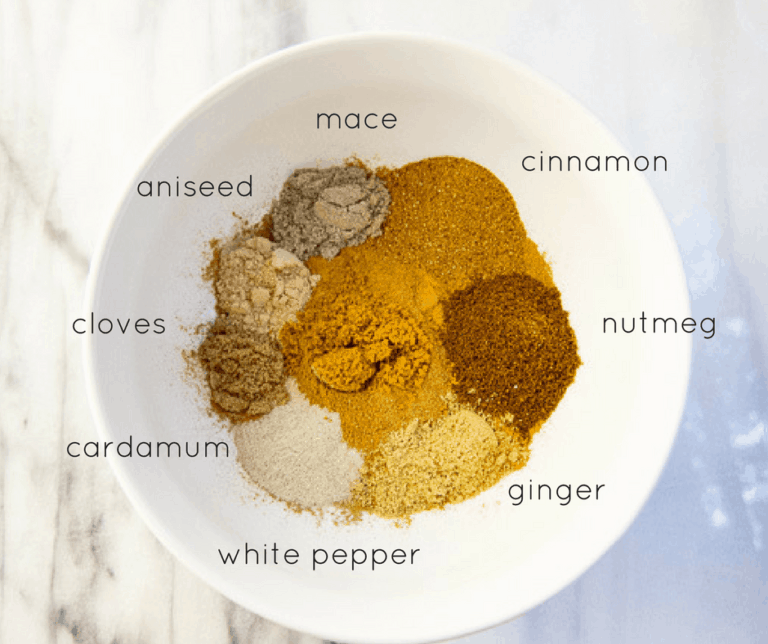
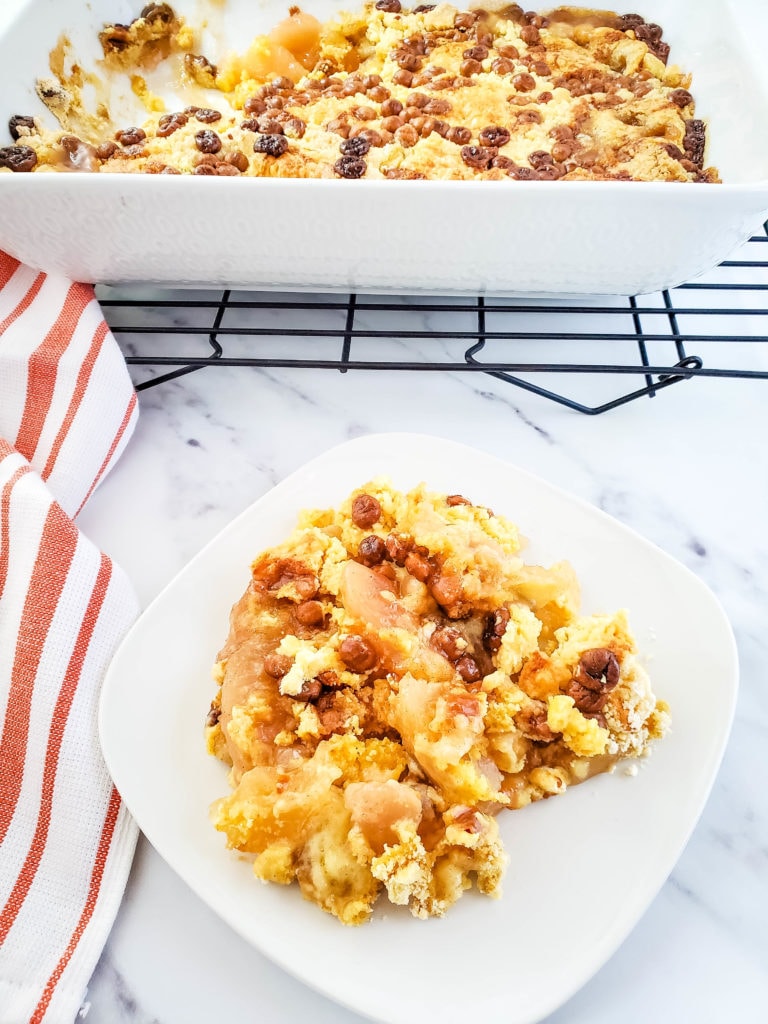
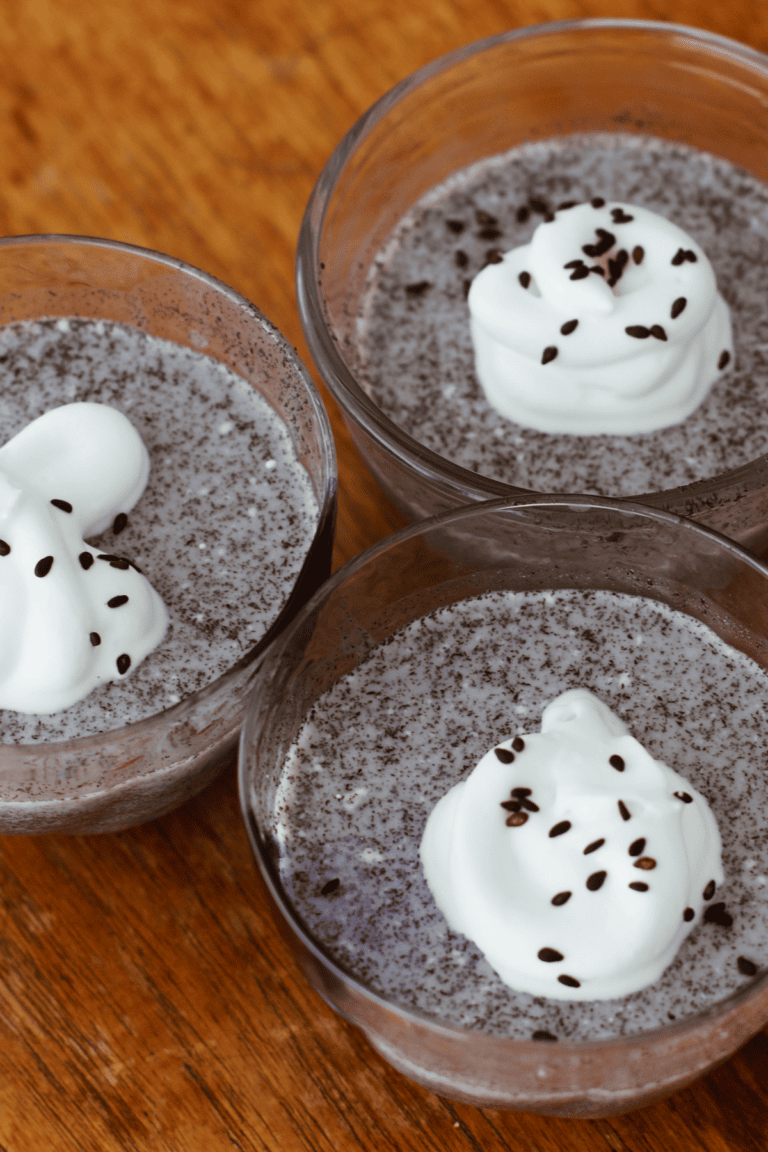


Cate, I make clotted cream all the time and can tell you it freezes beautifully! Since about a half cup of clotted cream seems to be the usual amount of clotted cream that gets used at one of my afternoon tea parties, I freeze it in that size jars and just thaw one out when needed.
Hi Jean! I’m so glad to hear that it freezes well. I’m going to make up another batch for the freezer so I’ll always have some on hand.
Do you leave the oven on for 24 hours to male clotted cream???seems such long time or is it just the original heating up the oven to 180degrees farenhight I know that sounds stupid but would like to know please
Hi Angelina, I leave it in the oven for about 12 hours at 180F then in the fridge for 12 hours.
My family loves clotted cream. All of the cream we can get near us is ultra pasteurized. This will definitely work, you will just not have as high a yield. At 175, my oven does an auto shutoff, so I do 12 hours at 180. I always chill in fridge for 8 hours before skimming. However, I now have two full pounds of fresh clotted cream waiting for the scones I will make tomorrow for Christmas morning breakfast. That took two quarts of heavy ultra pasteurized cream from Brookshires (40% milkfat). I had four cups of liquid cream left, but fortunately, we all love cream in our coffee. So it is a win win ! Lol
I’m glad to hear that! I wish it were easier to find the non-ultra pasteurized cream but good to know that it *can* work with the ultra pasteurized. I wonder if some brands work better than others.
@Cate, International Desserts Blog,
Half of the heavy cream examples I find in US supermarkets have added a stabilizer like gellan gum to enhance shelf life, and all of them are ultra-pasteurized.
Stabilizers may contribute to the difference.
My first attempt was 1 pint, in an open round container, which was relatively small compared to what everyone else is using. It didn’t look ‘done’ at 12hr, so I just kept going another 12hr.
Floating atop the buttermilk, the clotted cream ended up developing a rich, tan, crumbly pie crust texture at the top with a unique flavor, and very sticky peanut-butter-like cream under that.
I drained off the buttermilk and packed the clotted cream into one container. It ended up being a bit solid and difficult to spread straight out of the fridge, which is not how I’d imagined it, but tastes great in a thick layer. Further experiment showed that you can reduce this solid tendency by mixing back in SMALL quantities of the buttermilk and stirring it while cold. 1tbsp is arguably too much, and rendered things mostly liquid.
I’ve observed that Americans experienced a largely unnoticed shift when we started refrigerating butter and deep-freezing ice cream; Colder fat is more solid fat, and all of a sudden “soft as butter” became an anachronism, and an ice cream scoop became a crowbar. It took decades for manufacturers to introduce an innovation like ‘spreadable butter’. I expect that this style of clotted cream at room temperature would be perfectly spreadable, and that this was probably the traditional way to serve it, but either less time than 24hr baking or some re-blend with the buttermilk is best for a spread that I’m going to store in a 1C refrigerator.
Yes! It’s so hard to find non-ultra pasteurized cream in the US. Even most brands of buttermilk have stabilizers and other things added. I’m on the look out for a new brand of cream because the local dairy where I bought my non-ultra pasteurized cream for clotted cream just closed. Such a bummer! 🙁 I keep a little of the whey to add back into my clotted cream if it becomes too thick. I’ve found it always tastes great, even if it’s a bit thicker or thinner than I was going for. Thanks for sharing your experiences – I always love hearing about the process and results!
How much clotted cream can you expect from a quart of heavy cream-I may be crazy but am having a 20 person tea party on Saturday so don’t have much time to experiment!
A tea party sounds like so much fun! I usually get about 1/2 cup of clotted cream for each pint of heavy cream (sometimes a little more, sometimes a little less). So I’d think you’d get about a cup from a quart of heavy cream (it depends on how well it clots). To be on the safe side, for 20 people I think I’d make more than a quart, just in case (you can always freeze the leftovers) – or buy a jar to have on hand. Have a great tea party!
I would be interested in hearing any more reports from people who have used ultra pasteurized cream. It’s a 45 minute trip from here to the nearest shop that “might” have the non-ultra stuff, which makes it hard to throw together a batch of CC on impulse. This is the only blog I’ve found where anyone seems to have actually tried it with the ultra, most of the others seem to be just repeating what they have read elsewhere, rather than actually take the time to try it.
It would be interesting to hear that! I have to go to a special store to find the non-ultra-pasturized cream. I’m making a batch of clotted cream later this week so I’ll give the ultra-pasturized another go and will let you know how this batch turned out vs. the non-ultra-pasteurized. I tried Trader Joe’s heavy cream last time so this time I’ll try a different brand and see if that makes any difference!
When I made it, we got ultra pasteurized cream by mistake, but decided to go for it anyway. It DID work. I don’t know if it was as good as it would have been with pasteurized cream, but it tasted as good as the stuff you get in the jars. Also, it was a LOT cheaper! I will try to get pasteurized cream from now on, but in a pinch, you can use ultra pasteurized.
I’m glad to hear it worked! Did you have a lot of whey left over? I always find I have more whey ultra pasteurized.
Is it appropriate to have scones and clotted cream for an evening dessert?
I don’t see why not! You could put out a couple different flavors of jam and some lemon curd with the clotted cream and it would be delicious. Personally, I’ll eat scones any time of day. 🙂
I made some clotted cream for the first time, and had never had it either. Was able to use fresh unprocessed Jersey cream. I don’t think I’ve ever had anything better than this. It was beyond amazing. Almost a fresh caramel taste. No additives but just straight cream. Made currant scones and used Wilkins and sons strawberry preserves. I did mine the Devon way, cream first? made Harney and sons Earl Grey tea with it, with a spoonful of regular Jersey cream in that as well. Divine
That all sounds delicious!! Fresh, homemade clotted cream is such a treat, especially with scones, jam, and tea! I’m glad you enjoyed it. 🙂
I tried this recipe with the pasteurized (not ultra-pasteurized cream). I baked it uncovered for 12 hours at 180 degrees and then refrigerated it for 8 hours. Mine looked a lot like the picture from your first batch. What is the yellow part on top that is kind of hard? Underneath that layer was a nice thick layer of clotted cream but I had to fish out the yellow pieces. Are you supposed to include the yellow part in the finished clotted cream? I haven’t seen anything that mentions that part.
Love the simple delicious recipe; thanks for sharing!
Some people do include the crust part. It has more of a butter consistency but can also be kinda grainy. It’s ok to eat, it’s just the part that’s gotten hard in the oven. Depending on how hard it is, you might be able to mix it into the creamier part. If you don’t want a crust to form, try covering the cream with foil or taking it out of the oven sooner. Or try the method I used under Round 6 – that yielded the best results for me…with no crust!
HI there! What about a 9×13 Pyrex, will that still work? Your recipe said 9×9. Thanks in advance!
That should work! You want to make sure you have enough heavy cream in the dish, so if you pour in one pint and it doesn’t cover the pan, add a little more cream.
Hello! I have 2 questions: in Round 6, was the cream covered with foil or uncovered? Also, do you skim the clotted cream off immediately after taking it out, or do you wait until it cools to room temperature? Thanks.
1) For that particular batch I’m pretty sure I left it uncovered. Looks like I need to make it that way again so I can be sure 😉 2) I let the cream chill in the fridge before skimming it. Enjoy your clotted cream! 🙂
How long should I keep the cream in the oven if I am just baking a half pint of heavy cream in a small pyrex dish?
I’d plan for the same amount of time but check on it to see if it’s done early. I haven’t made a small batch so I can’t say for sure if or how much less time it would need. Let us know how it turns out for you!
Baked mine at 180 for 12 hours..looks kinda grey on top ???
Hmmm…not sure why it turned grey! Whenever I’ve made it, the clotted part turns butter colored. Did it smell or taste ok?
Haven’t tried it yet , couple more hours in the fridge , I’ll let you know
All I had was ultra pasteurized heavy cream, so I wasn’t sure what to expect as an end result. I used the preheated to 360° method, off for three hours then 180° it worked beautifully! High yield of clotted cream, just a small reserve of heavy cream left over. Creamy, thick, delicious!! Thank you for this great recipe!!
Which brand of cream worked well for you? I got some non-ultra pasteurized cream for the clotted cream I just now put in the oven but I’d like to try it again with ultra-pasteurized cream (the brands I’ve used didn’t work but I’m wondering if they might with the 360/180 method)!
Hi,
For the Round #6 version, did you cover the cream at 360F for 3 hours, or was it uncovered?
I left it uncovered.
@Cate in the round 6 you said you left it covered. So did you or didnt you.
Thanks for asking about that! I’ve tested so many methods by now that after decided that covering it is the best method I updated the article and recipe but not the comments. I do get the best results when I cover the dish with foil!
Hiya!
What if you made Round #2 with a couple of pinholes in the foil? Looks to me like you have too much liquid retained in your pan. Letting the moisture out should allow it to thicken a bit.
We have used an instant pot on yogurt setting with the vent open. I really want to use easily accessible ultrapasteurized cream.
The soupiness was your only complaint, other than that it was delish?
Thank you.
Hmmm…that might work? I might give it a try next time I have some heavy cream. For batch #2 the taste was good but it was indeed too soupy.
Readers have commented having success using ultrapasteruized cream so perhaps it’s finding the right brand. The ones I’ve used have never turned out well! Sounds like you’ve had good luck with making it in the instant pot? Even with ultrapasturized cream?
Will the clotted cream be thick immediately coming out of the oven or is that the magic that happens sitting in the refrigerator?
Parts of it will be thick (the “clots”) but it thickens up more after being in the fridge.
Lovely write up on the experiments – however if you want to get the real stuff you need Non pasturised, non homogonated milk – which is a bit difficult in the USA (considering since the 20s all milk has been required by the FDA to be pasteurised) – but you can find the real stuff in some smaller English stores
Yeah, that is harder to find in the US! We have a dairy near us that produces good cream (that’s not ultra pasteurized), and I use their cream all the time…but I’d love to go back to the UK to try the locally made versions.
?Try locating the non-pasteurised cream at your local Menonite/Amish store…i get alot of my odd cooking ingredients from one in my area?
That’s a great idea!
@Chris, I’m pretty sure you can’t get cream from homogenized milk at all. They reason they homogenize milk in the first place is to mix the cream in so it doesn’t separate out and rise to the top. You don’t need to homogenize cream because it’s already cream and doesn’t separate.
You’re pasteurizing the cream by heating it above 145°F for more than 30 minutes when you’re making clotted cream anyway. So no real benefit going for raw cream apart from knowing the farmer and how they treat their animals and supporting them. But as far as the final product goes, the enzymes and probiotics in the raw cream will be destroyed by the longer, higher heating process.
@Chris, Mill-King or Kalona brands work well if you can find them. We get both brands at Whole Foods and Sprouts. They’re low-heat pasteurized and non-homogenized.
I love clotted cream, but it’s almost impossible to find during the pandemic, and is terribly expensive online. I tried Alton Brown’s method and it was a dismal failure. I really want to try your method #6, but don’t want to screw it up! So, my question is, when you take it out of the oven and let it cool to room temperature, do you leave the foil cover on the whole time it’s cooling, or let it cool without the cover and then put the cover back on before refrigerating. I know that sounds like a picky detail, but I know these recipes can be persnickety just from little details like that! Thanks so much – after I hear back from you, I’ll let you know how it turns out!
Not persnickety at all! 🙂 I’m on a mission to figure out all of these little details so we can all make perfect clotted cream every time!!
To answer your question, I leave the foil on the whole time it’s in the oven, as it’s cooling, and then as it’s chilling in the fridge. I take it off now and then to check on it but mostly just leave it on.
Do let me know how it turns out!
Wow, Cate! It turned out PERFECTLY! I followed all of your advice to a “T”. Thank you so much for this incredibly easy and foolproof method. We love scones and clotted cream (especially around the upcoming holidays), and at $13 for a little 6 oz. jar, I was thinking we were going to have to give it up. Now, thanks to you, I can easily make it myself! Out of a quart of heavy cream, I got right around 15 oz. of perfect clotted cream, and two cups of whey. I only spent $7.99 on the quart of farm fresh heavy cream (not ULTRA pasteurized), so basically I would have had to pay around $32.50 to get the same amount of clotted cream in a jar, and it wouldn’t have the same super fresh taste. THANK YOU SO MUCH!!!
I’m so glad!! Did you buy the cream directly from the farm or is it something you found in a store?
Hi,
just a question. I tried the 12 hour method but the crust was quite hard and almost brown. The temperature you mentioned, are they fan-forced temperatures or normal conventional oven temperatures? I beginning to think I need to lower the temperature by 20C for fan-forced?
But apart from that it tasted beautiful!
They’re for a conventional oven so I’d lower the heat. Did you cover your dish with foil? That should help, too. Keep an eye on it towards the end – you might not need the whole 12 hours. Or try the very last method I mention – that’s the one that’s given me the best and most consistent results! Good luck! 🙂
I tried it again using the last method like you suggested and wow! Thank you so much for your help. LOVE it.
Soo very smooth and creamy and a large amount produced. I love your currant scones recipe too.
Very happy Jen 🙂
I’m so glad you like the recipes! 🙂
What % cream are you using?
I think it’s 36% or 38% (I don’t have a bottle of the cream I use for clotted cream in my fridge right now, otherwise I’d double check). I’m not sure if you’re in the US or not, but if you are, use “heavy whipping cream” (not ultra pasteurized). If you’re outside the US you might be able to get cream with a higher % of fat!
I used the Kalona Supernatural organic whipping cream (sold at most Whole Foods). It comes from pasture grazed cows on Amish and Mennonite farms. It tasted super fresh! My family all agreed it’s better than the stuff in the jar from England that we’ve been buying for years. Like I said, I used your method #6 and it was absolutely perfect. Thanks again!
I should be able to get that at my Whole Foods so I’m going to try that next time. I used to buy it once in a while, too, but homemade is SO much better! Same with lemon curd!
Update: I couldn’t find that cream at my local Whole Foods. Bummer!
Hi, I’m wondering about the temperature in the oven. Is 80C crucial? I’m thinking of doing this in a dehydrator. but it only goes up to 70C. Any thoughts on this?
According to the research I did, it looks like you can make it on a lower temp. I haven’t tried it in a food dehydrator, though, so I can’t say for sure. If you try it, let me know how it turns out!
I have read about clotted cream so much recently (huge reader! Mostly British based it seems lol), so I googled the recipe.
Thank you for this easy easy recipe!
I didn’t have scones the day after I cooked this up, so I made toast with strawberry rhubarb jam, topped with my very first batch of clotted cream!!!
I found the flavour to be slightly caramelly, it was SO good!
I’m glad you like it! Strawberry rhubarb jam sounds so good. Clotted cream is also delicious on pancakes, waffles, etc, but I do have a scone recipe if you want to make them. 🙂
Hello. I just made this using method #6 and pasteurized cream. It looks super runny! After more than 12 hours in the refrigerator:( Were you supposed to take the foil off when bringing the baked cream to room temperature? I’m not sure what could have gone wrong.
Hi Jenny!
Here are some things to troubleshoot:
1. Did you use non-ultra pasteurized cream? The ultra pasteurized stuff always comes out runny for me. Even if you used non-ultra pasteurized cream, you might want to try another brand. Even using the same cream time after time, sometimes my clotted cream is thicker and sometimes a bit runnier.
2. What kind of dish did you use? I’ve had the best results using a 3-cup pyrex dish with 1 pint of cream. That gives enough depth for the clots to form. When I’ve used shallower dishes I’ve had runnier clotted cream.
3. Did you leave it in the oven long enough? I always check it several times during the second bake at 180F and don’t take it out until I can tell that it has clotted. You might need to leave it in a little longer. You can take the foil off while it’s baking but I like to leave it on so I get a smoother texture.
4. There will be liquid whey after cooking and cooling. When I use the 3-cup pyrex I find it easiest to carefully drain off as much of the whey as possible before scooping out the clotted cream. That whey will thin out the clotted cream so drain it well!
I hope that helps! 🙂
I will have to take a run to Wegmans to see what they have and give it a try before I make it. We have a lot of Amish and Mennonite farms in the area. I will have to see if I can get non pasteurized heavy cream from them. I have been intrigued by clotted cream for a while. I am glad I found this page. Looking forwarding to trying it. If anyone if looking for a Wegmans, they are mostly in NY, then down the east cost. So far they have made it N.C., but only a few stores.
If you can get cream from an Amish or Mennonite farm, try that out! Readers have said they’ve had great results using cream from Amish or Mennonite farms. If not, try Wegmanns or Whole Foods. A Wegmans is about to open up where I live in North Carolina and I can’t wait!
FYI – I did use ultra-pasteurized because it’s what I had on-hand & it worked just fine! I followed the instructions exactly, with the elaboration that I waited well over 12 hrs to scoop the clotted cream away from the whey. I ended up waiting about 36 hrs just due to circumstance, and I got a lot of clotted cream (maybe a cup/ the container I put it it isn’t marked, of course! Hth) with a full 1/3 C. whey to put in my scone recipe. It was soooo delicious! I’m obsessed! Thank you!
P.S. when I first took from room temp to fridge I was worried that there weren’t too many yellow areas within the white watery ones, but by the time I took it out of the fridge to scoop, it was almost all yellow on top.
I’m so glad it worked for you! What brand of cream did you use?
I used ultra pasteurized heavy whipping cream because that is all that is available here in Denver (unless you belong to a milk delivery service). It turned out great! I used 1 pint Organic Valley and put it in an 8×8 glass dish. I had set my oven to 180 but the oven thermometer said it was 190-195. I’m not sure I trust the oven thermometer in my case because everything else I bake is completed on the regular baking time. It took only 8 hours though for my clotted cream to bake, and I ended up with only 1/3 cup whey/leftover cream. This shorter time could be due to the lower amount of cream perhaps, or if my oven did run warmer, it cooked it faster.
I’ll get some Organic Valley and will try it again. Maybe it will work better with my new oven. Thanks for the info! I’m glad that you and others have had good luck with the ultra pasteurized cream since it can be so hard to find the non-ultra pasteurized stuff!
@Cate, International Desserts Blog, I did leave the oven on the entire time and my cream had the more golden look to the top then your photos above. Organic Valley apparently also makes a pasteurized version, but again, that isn’t available around me.
@Cate, International Desserts Blog, Mine came out with a look/consistency more like Chef John’s (https://www.allrecipes.com/video/7373/chef-johns-clotted-cream/)
I’ve had some turn out like that, too. I’ve been covering mine with foil the entire time it’s in the oven and I’ve been getting the smooth white top. But as long as it tastes good, that’s what matters! I’ve got Organic Valley cream on my shopping list so if I can find it in the store tomorrow I’m going to try a batch with it this weekend. 🙂
@Cate, International Desserts Blog, Great! Let me know if it tastes as good or if it tastes noticeably different. It was still yummy, but I wonder if the creamier kind tastes different. I had it in England 2 years ago but don’t recall exactly how it tasted.
I definitely will!
@Cincolo, I tried Organic Valley ultra-pasteurized cream over the weekend and it worked! It didn’t turn out quite as thick and smooth as when I use non-ultra pasteurized cream but it did work. The taste wasn’t noticeably different but maybe I’d notice a difference if I did a side-by-side comparison. I used the heat to 360F/put cream in and turn oven off for 3 hours/then 7-8 hours at 180F method. I may try it again at 190-195F for 7-8 hours to see if it comes out thicker and smoother, since you said that worked for you. I’m wondering if the higher heat might work better for the pasteurized cream.
@Cate, International Desserts Blog, I let mine sit to get to room temperature after separating and then whisked it until smooth.
@Cincolo, Is it possible that the altitude in Denver affected the baking time? I understand that one needs to be mindful when baking at “higher altitudes.” A baker needs to make adjustments.
I have tried clotted cream just twice. Once in Scotland on my honeymoon and once in a tea shop close to home where they make their own. It was nicely sweet and creamy. I made this recipe last night using pasteurized 40% fat heavy cream. What resulted honestly just tastes like plain softened butter. Am I missing something? It is supposed to be sweet, right?
It can have a slightly sweet taste but the clotted cream I’ve had hasn’t ever been very sweet. And it can range from a butter-like consistency to very creamy, depending on the type of cream you use, your baking method, how much whey you leave in, and if it’s chilled. I’ve heard that unpasteurized cream yields the best clotted cream (and perhaps most like the “real” thing) but I haven’t yet found unpasteurized cream, so I can’t confirm. If what you had in Scotland was sweeter, it could be the cream they used is different from what you used (I think cream in the UK and other parts of Europe has a higher fat content?). Try using different kinds of cream (unpasteurized if you can find it) to see if you get the flavor you’re looking for! 🙂
I was so skeptical that I could turn store bought cream into my favourite clotted cream treat but it worked like an absolute dream. I had to use ultra pasteurized since that’s all that was available. My yield filled a 500 ml mason jar. I’m so excited.
I’m so glad it worked for you! What brand of cream did you use?
@Cate, International Desserts Blog,
It’s Neilson. I would say it’s the most common brand in my region. I found some regular pasteurized this time so I’m interested to see what results I get.
I would have never thought I could make this in my home. I used to buy Devonshire clotted cream off the shelf but I can’t find it anywhere lately. I’m very glad to have found this helpful recipe.
I don’t think I’ve seen that brand in my area but I’ll keep an eye out for it. It’s so nice to be able to make it at home, isn’t it?
Have you tried to “reclot” the whey? When I made clotted cream, years ago, I would skim off the clotted cream, then reheat the whey and refrigerate it, again, and would get a little more clotted cream, which cut down the total whey amount.
I haven’t tried that but I’m going to next time I make clotted cream! Thanks for the tip. 🙂
I made clotted cream using this recipe once before and had great results! This morning, I made a bonehead move and put the cream in the oven at 350 and then forgot to turn the oven off! It was in for about 1hour before I realized the mistake! I then turned the temperature down to 180 and left it for about 6 hours. Is the cream ruined? I took a small taste and it did not taste burnt. I did have it covered with aluminum foil. The color is a light caramel. Any suggestions?
I’ve done that, too! (Only I didn’t catch mine until it had burned.) If yours clotted ok and it tastes ok it should be fine!
Bravo pour votre méthode de clotted cream ! Fabuleux ! MERCI
Marc de Strasbourg, Alsace
Je vous en prie!
Have you ever tried making it in an instant pot? I’ve seen recipes, but haven’t actually tried it yet
I don’t have an instant pot so I haven’t yet tried it. I did try it in the crockpot and didn’t like how it turned out. But it might work in an instant pot? If you try it, let me know how it turns out!
Made clotted cream the other day, for the first time, from another post. No mention of pouring off whey, no tip-off about it being brown, and just not helpful about what to do or expect at all! Couldn’t even use it for my beautiful scones! Thank you so much for these thorough instructions! I was not willing to give up and found your blog. Can’t wait to try your recipe!
You’re welcome! 🙂 I hope you get to enjoy scones with clotted cream very soon!
I tried your 360 turn off oven method and it worked great!!
Thank you!
~Melanie
You’re welcome! 🙂
Thank you for this amazing recipe!! I made this for Afternoon tea for Mother’s day this year and it was a hit! So easy! I used a pint of Pasteurized (not Ultra) Organic Valley heavy cream from Whole Foods and used a glass 8×8 baking pan. I learned a tip from a British recipe to have the liquid 1-3″ high, and mine was just about 1″ high in an 8×8 pan. No deep yellow crust on top (I kept the foil on the entire time, I never opened it)! When it came time to drain the liquid whey, I kept the foil tightly on the pan and just tore off a corner from the foil and used a slotted spoon in that open corner to catch any solids (which none came) as I tipped it. Super easy to drain this way rather than trying to scrape off the top layer. I was able to fill (maybe 3/4th full) four 4-oz canning jars with this recipe. The clotted cream was super thick like scraping cold white butter, so I mixed some of the whey back in with it to get it creamier.
I love that you showed all your trial and errors and the differences in results. That saved me all so much time in testing other methods knowing that you did all the hard work! Thank you!
I’m curious what happens after the shelf life of the clotted cream. After 3-4 days, does it just become liquid or turn sour?
You’re welcome! I’m so glad you liked it. Isn’t it great to know you can make it at home? My clotted cream has always been eaten up pretty quickly so I’m not actually sure what happens when it goes bad! lol I think I need to do another experiment. 🙂
Hi,
I want to also report success with using the ultra-pasteurized heavy whipping cream from BJs Wholesale — the store brand that is specifically labelled 36% fat. I wasn’t expecting much, but I hadn’t had time to make a trip to Wegmans.
I can report that after leaving a quart of cream in the oven for 12 hours at 180F, I got about 14 ounces of clotted cream; enough to almost completely fill a 16 oz salsa jar. I used an 8 by 11.5 inch baking dish (covered). Might I get better results with a larger 9 x 12 or 9 x 13 dish?
Those results sounds great, especially with ultra pasteurized heavy cream! How much whey did you have left over? You definitely try a larger dish and see if you get better results but make sure there’s enough cream in the dish – there needs to be enough cream to form clots. If there isn’t as much cream you’ll just get a thin layer of clotted cream (hope that makes sense). Thanks for sharing your results!
@Cate, International Desserts Blog,
I think I got about 2 cups of whey, which makes sense, I guess, maybe a little more. If 1/3 or so of the original contents was fat, that’d go into the clotted cream, along with some moisture… then there’s the evaporation, and the remainder would be the whey.
One thing I did try and don’t recommend…putting the leftover whey back for a second round of heating and cooling. When I tried this the first time, I left it in for about 8 hours, and I wanted to see if I could extract any more clotted cream. It wasn’t really worth the efffort for the miniscule amount I got. Plus, I’m not sure whether it was safe to eat.
Next time I make a batch, I am going to try your ice cream recipe. Do you think (evaporated) coconut milk will work for the milk portion?
Thanks for sharing that! I always love hearing what works, what doesn’t, and how things turn out. For then clotted cream ice cream…I think evaporate coconut milk will work. I’ve never used it in that recipe so I can’t say for sure, though. It looks like evaporated coconut milk doesn’t have a coconut flavor and coconut milk can be used in place of cow’s milk in most recipes, so it sounds like it could work. If the evaporated coconut milk has a high fat content, I’d use a little less clotted cream, otherwise the ice cream could become too “greasy.”
Hi Cate, I’m a bit confused, on the recipe it says cook time is 12 hours. But in the instruction you write to preheat oven at 180C then turn it off and let the cream set for 3 hours. Then turn oven on at 80C for 7 hours. Should the cream be at 80C for 9 hours or is the cooking time really 10 hours? Thanks
Thank you for catching that (just fixed it)! Cook time is about 10 hours (chill time is about 12). After the first 3 hours in the turned-off oven, I usually need about 7 more hours on that lower temp. But check yours as it nears 7 hours at 80C because you might need a little more or less. Hope that clears things up!
Have you tried making clotted cream in a sous vide with a vacuum sealed bag? I may try. Consistent temperature and can cook while you’re not at home. Maybe harder to separate whey from curds?
I haven’t tried that yet but I’ve heard it works. If you try it, let me know how it goes!
Always always put the jam on first! Then the cream! Please that’s the Real way it should be done…JAM FIRST…xxx❤️?
I married a Cornishman…Always JAM FIRST then the CLOTTED CREAM. Xxx Beautiful xxx
I’ve heard it’s done both ways, just depends on where you are 🙂
So I just watched a show called Edwardian Farm, in the show they make Clotted cream, the show was filmed in Devon. I’ve been looking at a lot of recipes and none come close to the simplicity of the method used on the show. A Pan was filled with boiling water and a bowl with Milk, unpastureized full fat milk pretty much straight out of a cow. The pan was then left for 12 hours uncovered and then skimmed and served. The older woman on the show said, “And that’s how you make devon cream” Curious if you’ve tried anything like this, I imagine the simplicity of the process is due to the fact that in the early 1900’s not everyone had and oven ?
I’ve seen that show and know exactly what you’re talking about! I haven’t tried that method but I’m so curious about it. I bet it was because they weren’t able to put the clotted cream in an oven with a consistent low temp for 12 hours and then chill it for another 12. I haven’t found a place in my local area to get unpasteurized cream but if I can at some point, I want to give that method a try!
i thought the recipe for clotted cream ice cream would contain clotted cream, but the ingredients state “heavy cream”…
The recipe includes both heavy cream and clotted cream.
Hello Cate,
I finally made your clotted cream recipe. I followed all steps, including buying that 3-Cup Pyrex dish. When I took the dish out of the refrigerator this AM, it was easy to pour out the whey. But, my clotted cream had a consistency more like marshmallow fluff! It tasted good, but it was sticky. I wish I could post a picture! Do you have any clue as to why the clotted cream turned out that way?
It could be the cream you used (I’ve made batches of cc the same way but using different brands of cream and they’ve turned out differently!) — or it could be that the cc needed to chill in the fridge a little longer after pouring off the whey.
I saw your answer below re: time in oven. You said 12 hours total. The recipe I have is: Oven at 360. Put dish in. Turn oven OFF. Let sit for 3 hours. Leave dish in oven and turn heat back on to 180. Let dish bake at 180 for 7 hours. (That’s 10 hours). Let come to room temp (that took about 1. to 2 hours) then refrigerate for 12 hours. That was the recipe I followed. Just FYI so you know what timing I followed to get my sticky cream. Still usable! Just curious.
You’re right, it is about 10 hours in the oven (and about 12 hours in the fridge to chill)! That said, I’ve let the cream stay in the oven for 12 hours if it needs it. If it’s covered with foil it’s usually ok staying it longer. I always set a timer to check at 10 hours total and then leave it in longer as needed.
Re: sticky clotted cream — from my experience, it’s either the type of cream you used or the cc needed to chill in the fridge for a bit after pouring off the whey. Some creams I’ve used create sticky cc and others are sticky right after pouring off the whey but firm up nicely in the fridge. Hope that helps! 🙂
Just FYI — In the midwest USA, Anderson Erickson Cream (A&E) is NOT ultra pasteurized. Have not used it yet. Waiting for your response to my previous comment re: sticky clotted cream. Thank you so much!
Alida
Just replied to both of your questions/comments! 🙂
Hi I recently tried this recipe and it came out like Elmers glue. After upgrading to organic cream and getting the same consistency, on my third try I did not cover with foil and had much better results!
I’ve had that happen, too! Usually because I didn’t get enough whey drained off or it needed to chill in the fridge longer after draining off the whey. And some brands of cream I’ve tried just don’t seem to work as well as others. It often takes a few tries to find the right cream and method/timing that works for your oven. I’m glad you were able to get good results the third time! How long did you leave the cream in the oven without foil?
Hi Cate, thank you for your true and tried recipe for clotted cream.
I have recently made it using my air fryer. I have to say it worked well. I will just adjust the timing in the future to try and have it less browning the top.
There was no whey to drain, just beautiful smooth cream ( except for the brown on the top).
Thank you again for the tips.
I am definitely going to check out your other recipes.
Cindy, Calgary AB
I just now saw your comment! Thank you for sharing that – I’ve wondered how it would work in an air fryer! Did you cover the top with foil?
I am experimenting with your clotted cream recipe today in preparation for a club tea next week. Someone else is doing scones.
I’ll try freezing some of the clotted cream to see how it thaws.
I did ask this on the scone recipe page. Regarding the whey, you say it can be used in the scone recipe–Is the whey the substitute for the milk?
Can the whey be frozen for later use?
If the whey can be frozen, I hope; then the whey from homemade yogurt can be frozen too?
This would be such a bonus I think for future baking (maybe another hedge against recession?) Someone recently commented on another page about the throwing out of the whey and it should not be put down a sink drain. If it can be frozen, that certainly solves that waste problem. Otherwise, just pre-plan recipes the week you make clotted cream or yogurt.
I’ll try freezing some of the clotted cream to see how it thaws. I like the idea of freezing the scones uncooked too.
Thanks.
Yep, you can use the whey in place of some of the milk. I do still use some milk (or cream) when I make scones, though. I usually use any whey from clotted cream or yogurt right away but you can freeze it. If you freeze in small quantities that’ll make it quicker to thaw and you could also easily add it to smoothies!
I really want to make clotted cream but I can’t afford to leave my oven on for seven hours. ??
It’s on a very low setting after the first bit. 🙂 I’ve heard people have made it in a slow cooker so you could try that. I’ve had better luck in the oven, though. If it’s going to use too much electricity (definitely a concern right now!) I’d just go buy it – it could turn out to be less expensive!